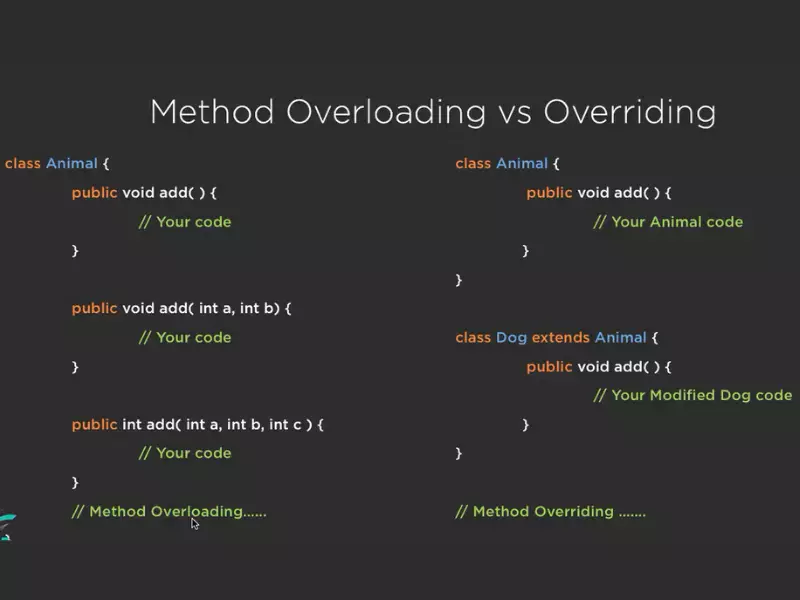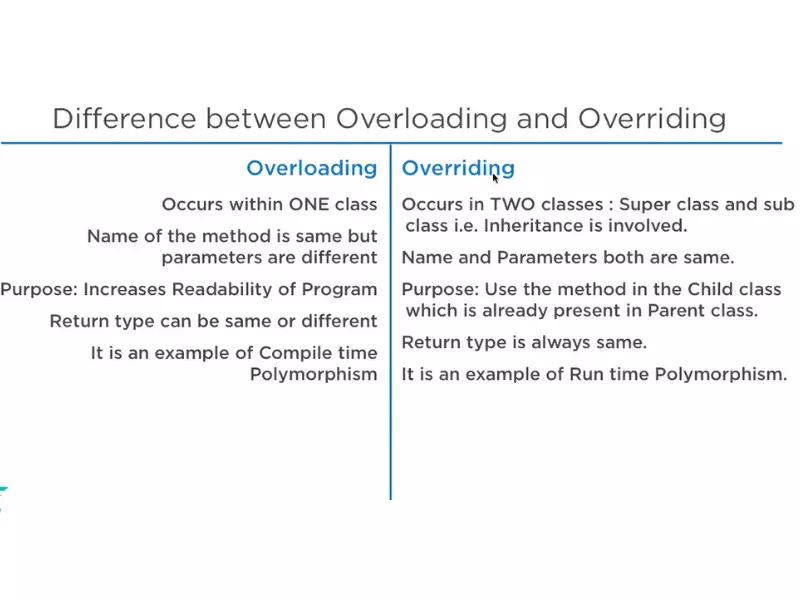Java stands as a cornerstone in the world of programming, renowned for its object-oriented capabilities that empower developers to create versatile, efficient, and maintainable code. Among its myriad features, two that frequently capture the attention of Java practitioners are overloading and overriding. These concepts, while distinct, play pivotal roles in enhancing the functionality and readability of Java applications.
Overloading occurs when two or more methods in the same class have the same name but differ in parameters (either in number, type, or both). Overriding, on the other hand, involves redefining a method in a subclass that already exists in the parent class, enabling polymorphic behavior. Essentially, overloading optimizes code usability within a class, while overriding modifies inherited behavior across classes.
Understanding these two mechanisms is crucial for Java developers, as they underpin the polymorphic capabilities of Java, enabling both compile-time (overloading) and runtime (overriding) polymorphism. This distinction not only aids in creating more dynamic and flexible code but also fosters a deeper comprehension of Java’s object-oriented nature.

Java Basics
Brief on Java Programming
Java, a high-level programming language, is known for its simplicity, object-oriented nature, and security features. It enables developers to create robust, portable applications for various platforms. Java’s write-once, run-anywhere (WORA) capability makes it a popular choice for developers around the globe.
Object-oriented Principles
Java is built on four foundational object-oriented principles: encapsulation, inheritance, polymorphism, and abstraction. These principles facilitate the creation of flexible and maintainable code, making Java an ideal language for complex software development.
- Encapsulation ensures that sensitive data is hidden from users.
- Inheritance allows the creation of new classes that inherit attributes and methods from existing classes.
- Polymorphism enables a single action to behave differently based on the object that performs it.
- Abstraction reduces complexity by hiding intricate details and showing only the necessary features of objects.
What is Overloading?
Definition
Overloading is a concept where two or more methods in a class have the same name but different parameters. It is a form of polymorphism that allows methods to perform similar actions but with different inputs.
How it Works in Java
In Java, overloading is determined at compile time. The compiler selects the appropriate method to execute based on the method call’s parameter list.
Key Characteristics
- Same method name, different parameters.
- Can apply to both methods and constructors.
- Improves code readability and usability.
Overloading Examples
Method Overloading
Method overloading enables a class to offer multiple methods with the same name but different parameter lists, enhancing its functionality.
- Example:
print()method could be overloaded to print different data types.
Constructor Overloading
Constructor overloading allows a class to have more than one constructor, each with a different set of parameters, making object instantiation flexible.
- Example: A
Rectangleclass could have constructors that define a rectangle by specifying different sets of parameters like length and breadth or just the side for a square.
Advantages of Overloading
Improved Code Readability
Overloading makes the code more intuitive by allowing method names to reflect a consistent operation across different input parameters.
Increased Reusability
It enables developers to write versatile methods that can be called with different types of parameters, thus reducing code duplication.
What is Overriding?
Definition
Overriding is a feature that allows a subclass to provide a specific implementation of a method that is already defined in its superclass. It is a key aspect of Java’s support for runtime polymorphism.
Overriding in Java
In Java, method overriding occurs when a subclass has a method with the same name, return type, and parameters as a method in its superclass. It enables Java’s dynamic method dispatch, allowing the invocation of overridden methods at runtime based on the object’s actual type.
Key Features
- Overridden methods allow subclasses to customize or replace the behavior of methods defined in their superclass.
- The
@Overrideannotation is used to indicate that a method is intended to override a method in a superclass.
Overriding Examples
Method Overriding Scenarios
Method overriding is employed when a subclass needs to modify the behavior of a method inherited from its superclass.
- Example: In a
Vehicleclass hierarchy, aCarsubclass might override themove()method to include specifics about car movement.
Advantages of Overriding
Dynamic Method Dispatch
Overriding supports dynamic method dispatch, which is crucial for implementing runtime polymorphism. This means that the method call’s behavior can change at runtime, depending on the object’s actual class.
Enhancing Functionality
It allows subclasses to enhance or modify the functionality of methods inherited from the superclass, providing a powerful mechanism for code reuse and extension.

Overloading vs Overriding
Core Differences
Overloading and overriding in Java serve different purposes and operate under distinct principles. Overloading allows a class to have more than one method with the same name, as long as their parameter lists are different. It is a compile-time polymorphism. Overriding, in contrast, occurs when a subclass has a method with the same name and parameter list as a method in its superclass, allowing the subclass to provide a specific implementation for the method.
Comparison Chart
- Method Name: Same for both overloading and overriding.
- Parameter List: Overloading requires different parameters; overriding requires the same parameters.
- Return Type: Overloading can have different return types if parameters differ; overriding must have the same return type.
- Access Modifier: Overloading is not constrained by access modifiers; overriding requires the same or more visible access modifier.
- Polymorphism: Overloading is compile-time; overriding is runtime.
Context Usage
When to use Overloading
- To enhance readability.
- When methods perform similar operations but require different parameters.
When to use Overriding
- To provide specific implementations of inherited methods.
- To support runtime polymorphism.
Rules for Overloading and Overriding
Overloading Rules
- Methods must have the same name but different parameter lists.
- Can occur within a single class.
- Return types can be different, guided by the parameters.
Overriding Rules
- The method in the subclass must have the same name, return type, and parameters as in the superclass.
- The access level cannot be more restrictive.
- The overriding method can throw unchecked exceptions regardless of the superclass method.
Restrictions
Overloading Limitations
- Overloaded methods must differentiate by parameter types or numbers.
- May lead to confusion if not used judiciously.
Overriding Constraints
- Cannot override methods marked as final or static.
- Must adhere to the principle of substitution; the subclass method cannot narrow the access privileges.
Real-world Applications
Practical Examples of Overloading
- Math operations: Different methods for
add()that take various types of parameters, e.g.,add(int, int),add(double, double). - Constructor overloading: Allowing objects to be created with different initial states.
Practical Examples of Overriding
- Shape class hierarchy: A superclass
Shapewith a methoddraw(). Subclasses likeCircle,Square, overridedraw()to implement shape-specific drawing logic. - Animal class hierarchy: A
speak()method in a superclassAnimaloverridden by subclasses such asDogandCatto provide animal-specific sounds.
Impact on Java Development
The use of overloading and overriding profoundly influences Java software development. These mechanisms allow developers to:
- Enhance code readability and reusability through overloading, making methods more intuitive.
- Support dynamic polymorphism with overriding, enabling runtime decisions on method execution.
This adaptability and flexibility provided by overloading and overriding are instrumental in developing robust, maintainable, and efficient Java applications. They embody the core principles of object-oriented programming, offering developers powerful tools to solve complex problems with elegant and straightforward solutions.
Frequently Asked Questions
What is method overloading in Java?
Method overloading in Java refers to the ability to create multiple methods within the same class that share the same name but differ in their parameter lists. This can include differences in the number of parameters, their types, or both. Overloading allows for more intuitive code design, enabling methods to perform similar functions but with different inputs, thereby enhancing code readability and reusability.
How does method overriding work in Java?
Method overriding in Java is a feature that allows a subclass to provide a specific implementation of a method that is already defined in its superclass. This is done by declaring a method in the subclass with the same signature as the one in the superclass. Overriding enables Java to support runtime polymorphism, allowing the execution of the method version that corresponds to the object’s runtime type.
Can you overload Java constructors?
Yes, constructors in Java can be overloaded much like methods. Overloading constructors enables a class to have multiple constructors, each with a different parameter list. This flexibility allows an object to be instantiated in different ways, depending on the information available at the time of creation, thereby providing versatility in how objects are initialized.
What is the main difference between overloading and overriding?
The main difference between overloading and overriding in Java lies in their purpose and how they are used. Overloading is focused on giving a single method multiple forms based on different parameter lists within the same class. Overriding, however, is about modifying the behavior of an inherited method in a subclass, allowing for dynamic method execution at runtime. Overloading enhances usability within a class, whereas overriding enables polymorphic behavior across classes.
Conclusion
In the expansive realm of Java development, mastering the concepts of overloading and overriding is indispensable for crafting robust, flexible, and maintainable applications. These features not only exemplify Java’s powerful object-oriented principles but also equip developers with the tools to implement complex functionalities with simplicity and elegance.
As we continue to navigate through Java’s capabilities, appreciating the nuances between overloading and overriding becomes a beacon for better design decisions. By leveraging these concepts effectively, Java developers can ensure that their applications are not just technically sound but also intuitive and adaptable to future enhancements, embodying the true spirit of object-oriented programming.
